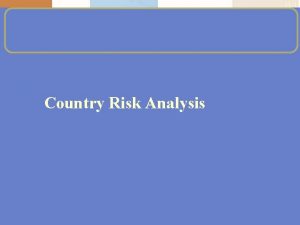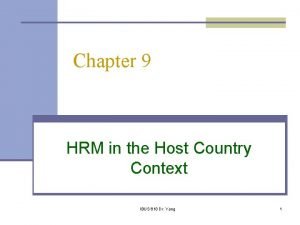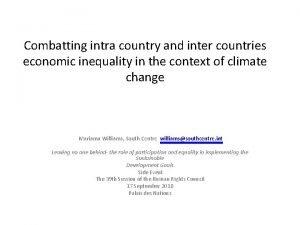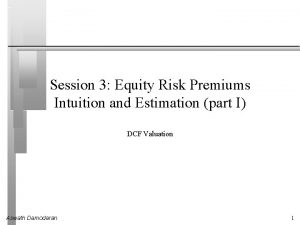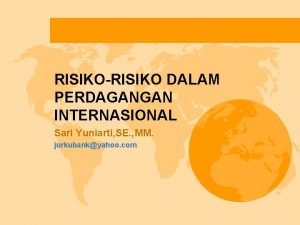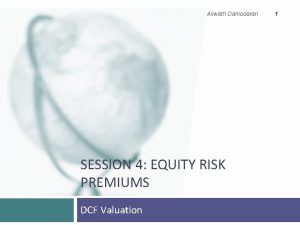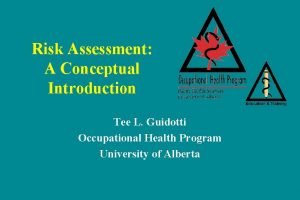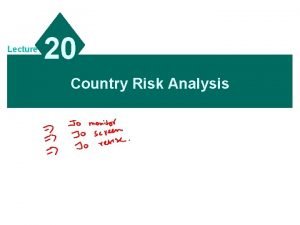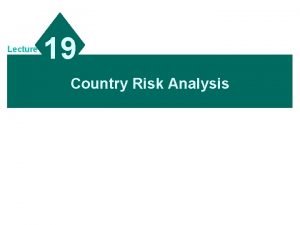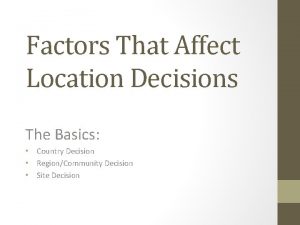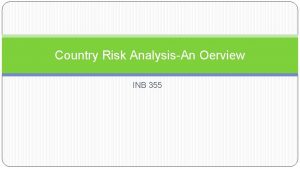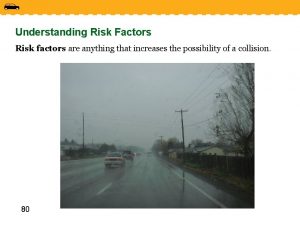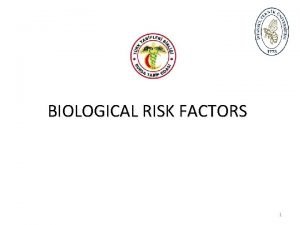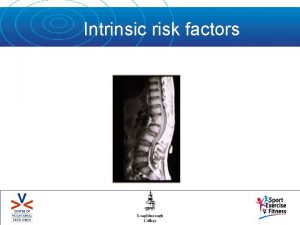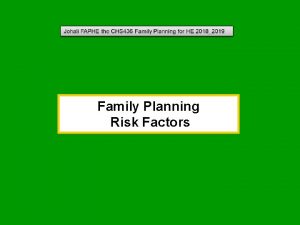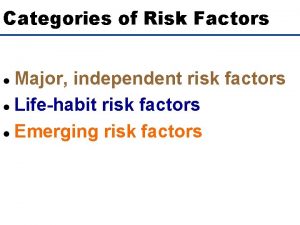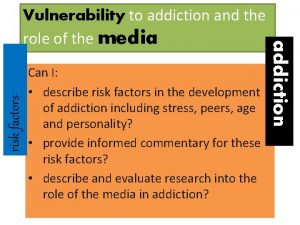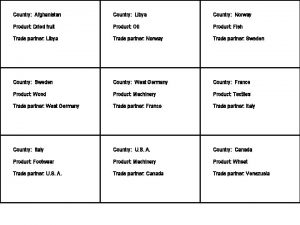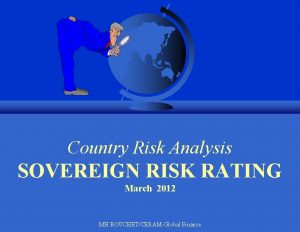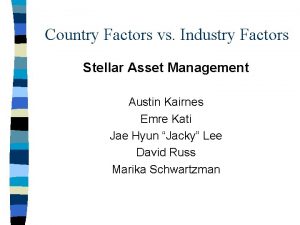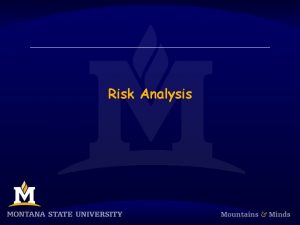11 1 Country Risk Analysis 11 2 Factors























- Slides: 23

11 -1 Country Risk Analysis

11 -2 Factors of Country Risk A. 1. 2. 3. 4. 5. 6. 7. Political risk factors: Attitude of consumers in the host country Attitude of host government Blockage of fund transfers Currency inconvertibility War Bureaucracy Corruption

Political Risk Factors n Attitude of Consumers in the Host Country n n Some consumers may be very loyal to homemade products. Attitude of Host Government n The host government may impose special requirements or taxes, restrict fund transfers, subsidize local firms, or fail to enforce copyright laws.

Political Risk Factors n Blockage of Fund Transfers n n Funds that are blocked may not be optimally used. Currency Inconvertibility n The MNC parent may need to exchange earnings for goods.

Political Risk Factors n War n n Bureaucracy n n Internal and external battles, or even the threat of war, can have devastating effects. Bureaucracy can complicate businesses. Corruption n Corruption can increase the cost of conducting business or reduce revenue.

11 -6 Factors of Country Risk B. Financial risk factors: 1. Current and potential state of the country’s economy 2. Financial distress can limit the MNCs market penetration 3. Probability of changing rules and regulations after establishing business 4. Additional host government restrictions may be enforced 5. Change in interest rate, inflation rate and exchange rate.

11 -7 Types of Country Risk Assessment 1. Macroassessment of country risk – it involves consideration of all variables that affect country risk except for those unique to a particular firm or industry. This type of risk is convenient in that it remains the same for a given country, regardless of the firm or industry of concern. Any macroassessment model should consider both political and financial characteristics of the country being assessed.

11 -8 Types of Country Risk Assessment 2. Microassessment of country risk – a microassessment is neceessary when evaluating the country risk as related to a particular project proposed by a particular firm. It would include the sensitivity of the firm’s business to real GDP growth, inflation trends and interest rates. This risk is related only to a specific firm in a specific country.

11 -9 Techniques to Assess Country Risk n n Checklist approach – it involves judgement on all the political and financial factors that contribute to a firm’s assessment of country risk. Some factors can be measured from available data, while others must be subjectively measured. Delphi technique – it involves the collection of independent opinions on country risk without group discussion by the assessors who provide these opinions.

11 -10 Techniques to Assess Country Risk 3. Quantitative analysis – in this assessment based on financial and political variables different types of statistical techniques such as regression, correlation and discriminant analysis are applied for measuring level of country risk. 4. Inspection visit – it involves traveling to a country and meeting with government officials, firm executives and consumers.

Developing A Country Risk Rating n A checklist approach will require the following steps: Assign values and weights to the political risk factors. Multiply the factor values with their respective weights, and sum up to give the political risk rating. Derive the financial risk rating similarly.

Developing A Country Risk Rating • A checklist approach will require the following steps: Assign weights to the political and financial ratings according to their perceived importance. Multiply the ratings with their respective weights, and sum up to give the overall country risk rating.

Developing A Country Risk Rating n n Different country risk assessors have their own individual procedures for quantifying country risk. Although most procedures involve rating and weighting individual risk factors, the number, type, rating, and weighting of the factors will vary with the country being assessed, as well as the type of corporate operations being planned.

Developing A Country Risk Rating n n Firms may use country risk ratings when screening potential projects, or when monitoring existing projects. For example, decisions regarding subsidiary expansion, fund transfers to the parent, and sources of financing, can all be affected by changes in the country risk rating.

Incorporating Country Risk in Capital Budgeting n n If the risk rating of a country is in the acceptable zone, the projects related to that country deserve further consideration. Country risk can be incorporated into the capital budgeting analysis of a project by adjusting the discount rate, or by adjusting the estimated cash flows.

Incorporating Country Risk in Capital Budgeting n Adjustment of the Discount Rate n n The higher the perceived risk, the higher the discount rate that should be applied to the project’s cash flows. Adjustment of the Estimated Cash Flows n By estimating how the cash flows could be affected by each form of risk, the MNC can determine the probability distribution of the net present value of the project.

11 -17 Reducing Exposure to Host Government Takeovers n n n Use a short-term horizon Rely on unique supplies or technology Hire local labor Borrow local funds Purchase insurance

Reducing Exposure to Host Government Takeovers The benefits of DFI can be offset by country risk, the most severe of which is a host government takeover. n To reduce the chance of a takeover by the host government, firms often use the following strategies: Use a Short-Term Horizon n n This technique concentrates on recovering cash flow quickly.

Reducing Exposure to Host Government Takeovers Rely on Unique Supplies or Technology n In this way, the host government will not be able to take over and operate the subsidiary successfully. Hire Local Labor n The local employees can apply pressure on their government.

Reducing Exposure to Host Government Takeovers Borrow Local Funds n The local banks can apply pressure on their government. Purchase Insurance n Investment guarantee programs offered by the home country, host country, or an international agency insure to some extent various forms of country risk.

Problem Rating assigned by Weight assigned by company to factor within a to factor according to range of 1 -5 point scale importance Political risk factors Factor A Factor B Factor C Factor D 4 3 2 1 30% 25% 35% 10% 4 5 3 1 25% 40% 20% 15% Financial risk factors Factor A Factor B Factor C Factor D

Problem The overall weight for political risk factor is 75% and for financial risk factor is 25%. Based on these information determine the overall country risk rating. If the risk rating of a given country is 3. 15, then the country would be preferred to make investment?

Impact of Country Risk on an MNC’s Value Exposure of Foreign Projects to Country Risks
 Factors affecting country risk analysis
Factors affecting country risk analysis Market risk credit risk operational risk
Market risk credit risk operational risk Host country and home country
Host country and home country Intra country vs inter country
Intra country vs inter country Brazil country risk premium
Brazil country risk premium Contoh country risk
Contoh country risk Damodaran.com
Damodaran.com Types of country risk assessment
Types of country risk assessment Measuring country risk
Measuring country risk Techniques to assess country risk
Techniques to assess country risk Country location decision
Country location decision Risk projection
Risk projection Risk reduction vs risk avoidance
Risk reduction vs risk avoidance Absolute risk vs relative risk
Absolute risk vs relative risk Residual risk and secondary risk pmp
Residual risk and secondary risk pmp Tracing vs vouching
Tracing vs vouching Absolute risk vs relative risk
Absolute risk vs relative risk Activity sheet 2 stock market calculations
Activity sheet 2 stock market calculations Risk classification systems
Risk classification systems Pembelanjaan risiko
Pembelanjaan risiko The biggest risk is not taking any risks
The biggest risk is not taking any risks Key risk indicators financial risk management
Key risk indicators financial risk management Ir x cr x dr
Ir x cr x dr Business vs financial risk
Business vs financial risk
